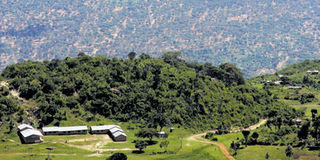Let’s tap the potential of local tourism

L. Kamnarok in Baringo County, viewed from Kerio Valley escarpment in Iten, Elgeyo-Marakwet County. PHOTO | JARED NYATAYA | NATION MEDIA GROUP
What you need to know:
- The real facts are that our tourist arrivals for 2015 were actually lower by 17 per cent over 2014.
Tourism has always been considered a vehicle for economic growth and job creation.
The tourism sector is directly or indirectly responsible for 8.8 per cent of the world’s jobs.
We take this beautiful country for granted, but if we just stopped to “smell the roses”, we would realise that there is so much to see and experience within our own borders.
The IMF report says that Kenya’s economy will grow by 6 per cent this year.
This is double the anticipated rate of growth for sub–Saharan Africa.
Part of the optimism is a note that says that there will be a recovery in tourism.
The real facts are that our tourist arrivals for 2015 were actually lower by 17 per cent over 2014.
Tourism has always been considered a vehicle for economic growth and job creation.
The tourism sector is directly or indirectly responsible for 8.8 per cent of the world’s jobs.
The World Travel and Tourism Council estimates that 3.8 million jobs could be created by the tourism industry in sub-Saharan Africa over the next 10 years.
Looking at the series of different events that affect this ability to grow tourism through international visitors, we realise very quickly that issues such as terrorism, political unrest, and safety can affect this growth tremendously.
BEAUTIFUL COUNTRY
Egypt and Kenya, specifically Mombasa, are good examples.
We have a growing middle class and we also have some amazing tourist sites all over this country that have not been marketed, yet they are beautiful.
I was driving from Eldoret to Kisumu a few days ago and went through the winding roads of Nandi Hills and I must say I was in awe of the lushness and breath-taking scenery.
Driving back to Nairobi, I decided to take the Bomet-Narok route and went through some beautiful country in the Rift Valley.
We take this beautiful country for granted, but if we just stopped to “smell the roses”, we would realise that there is so much to see and experience within our own borders.
These unique areas all over the country give us the perfect opportunity to promote local tourism.
We are beginning to see a start in this process in witnessing the counties stepping up to the plate and promoting their own areas.
We see some efforts in our government promoting local tourism.
There is a definite opportunity here to push this with more aggressive campaigns coupled with support to develop specific areas that can be enhanced with improved roads for better access, incentives for private business to invest in hotels and attractions, and for the counties and national government to get together to improve infrastructure, water, electricity, security, and to reduce the red tape to facilitate development.
I am not much of a social media buff, but when I see how savvy and comfortable the Kenyan is with this platform, I cannot help but think that we have an amazing opportunity to market local tourism in this way.
I bumped into a campaign christened #TwendeUshago (let’s go upcountry), which is being driven by Magical Kenya.
A closer look showed that the campaign was using local names such as omena to drive the message.
Whenever I travel with a team from Nairobi to Kisumu, almost all, and it does not matter what part of Kenya they come from, want to eat fresh tilapia from the lake.
I was born in Kisumu and lived abroad for a long time. I must say that growing up, I never appreciated what Kisumu had to offer.
If you have been to Kisumu you know the beauty of the lake and the breath-taking sunsets are unparalleled.
Taking a boat ride and watching the kingfisher hovering over the water, seeing the local fishermen in their canoes pulling in their nets and, if you are lucky, seeing hippos come out of the water to graze is such a treat.
Imagine you can drive out of the city for about five miles and actually stand on the Equator.
You can hike in the Kakamega forest and visit neighbouring islands such as Rusinga.
There are areas in western Kenya where you can go skydiving and water skiing.
One can now go to the lakeside city and have a great vacation instead of having to go all the way to Mombasa.
The multiplier effect of local tourism to the community is huge.
I am of the opinion that with a steadily growing middle class and the ability to market not only to the local Kenyan but to the rest of the region, this sector can grow, and if done right, has the potential to equal the international tourism income.
I must emphasise, though, that this can only happen if the national and county governments and the private sector work together to promote growth across the nation.
Tujenge Kenya pamoja!
The writer is the head of the Hospitality Division at Simba Corporation. [email protected].





